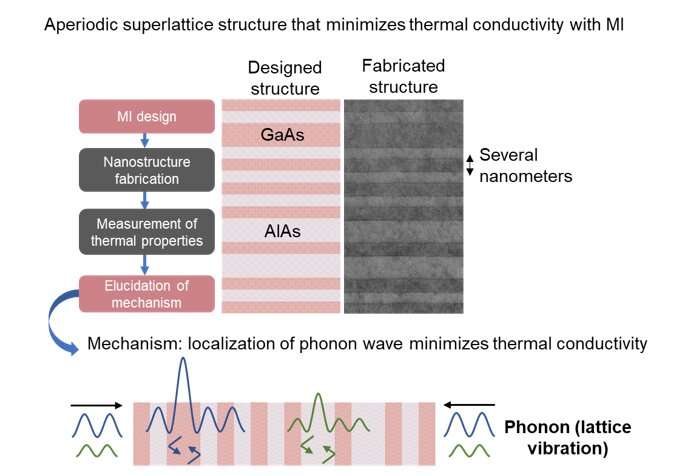#Minimizing thermal conductivity of crystalline material with optimal nanostructure
“#Minimizing thermal conductivity of crystalline material with optimal nanostructure”

Professor Junichiro Shiomi et al. from the University of Tokyo aimed to reduce the thermal conductivity of semiconductor materials by reducing the internal nanostructure. The researchers successfully minimized thermal conductivity by designing, fabricating and evaluating the optimal nanostructure-multilayer materials through materials informatics (MI), which combines machine learning and molecular simulation. In 2017, this research group developed a method to design an optimal structure that minimizes or maximizes thermal conductivity via MI based on computational science. However, it had not been experimentally demonstrated, and preparation of nano-scale structures and realization of an optimal structure based on property measurements were desired.
Thus, the research group utilized a film deposition method able to regulate, at a molecular level, a superlattice structure wherein two materials were alternately layered at several nanometers thick, and a measurement method that could assess thermal conductivity of a film at nano-scale, and realized the optimal aperiodic superlattice structure that minimizes thermal conductivity. With the optimal structure, wave interference of the lattice vibration (phonon) that conducts heat was maximized, and thermal conductivity was strongly regulated.
In the present study, using the semiconductor lattice structure as the model, the research group verified the utility of the MI method in design, fabrication, assessment, and mechanism toward regulation of thermal conductivity. In the future, application of the MI method to various material systems is anticipated. It was also shown that optimization of the aperiodic structure can regulate thermal conductivity by fully controlling the wave property of a phonon at near room temperature. This is expected to contribute to developments in phonon engineering for instance in thermoelectric conversion devices, optical sensors, and gas sensors, where low thermal conductivity is needed while maintaining electric conductivity and mechanical properties.
More information:
Run Hu et al. Machine-Learning-Optimized Aperiodic Superlattice Minimizes Coherent Phonon Heat Conduction, Physical Review X (2020). DOI: 10.1103/PhysRevX.10.021050
Provided by
Japan Science and Technology Agency (JST)
Minimizing thermal conductivity of crystalline material with optimal nanostructure (2020, June 12)
retrieved 12 June 2020
from https://phys.org/news/2020-06-minimizing-thermal-crystalline-material-optimal.html
This document is subject to copyright. Apart from any fair dealing for the purpose of private study or research, no
part may be reproduced without the written permission. The content is provided for information purposes only.
If you want to read more Like this articles, you can visit our Science category.
if you want to watch Movies or Tv Shows go to Dizi.BuradaBiliyorum.Com for forums sites go to Forum.BuradaBiliyorum.Com




